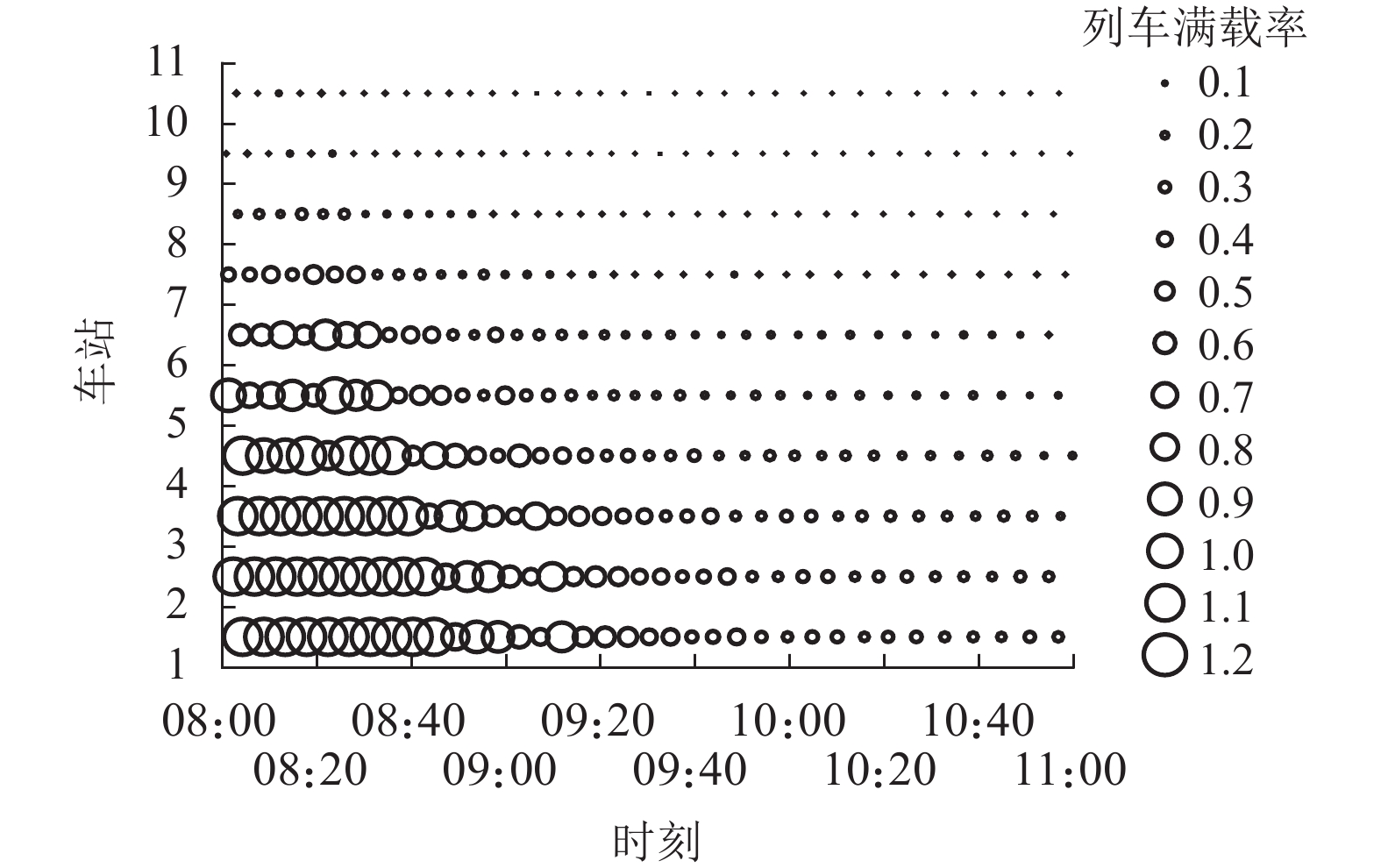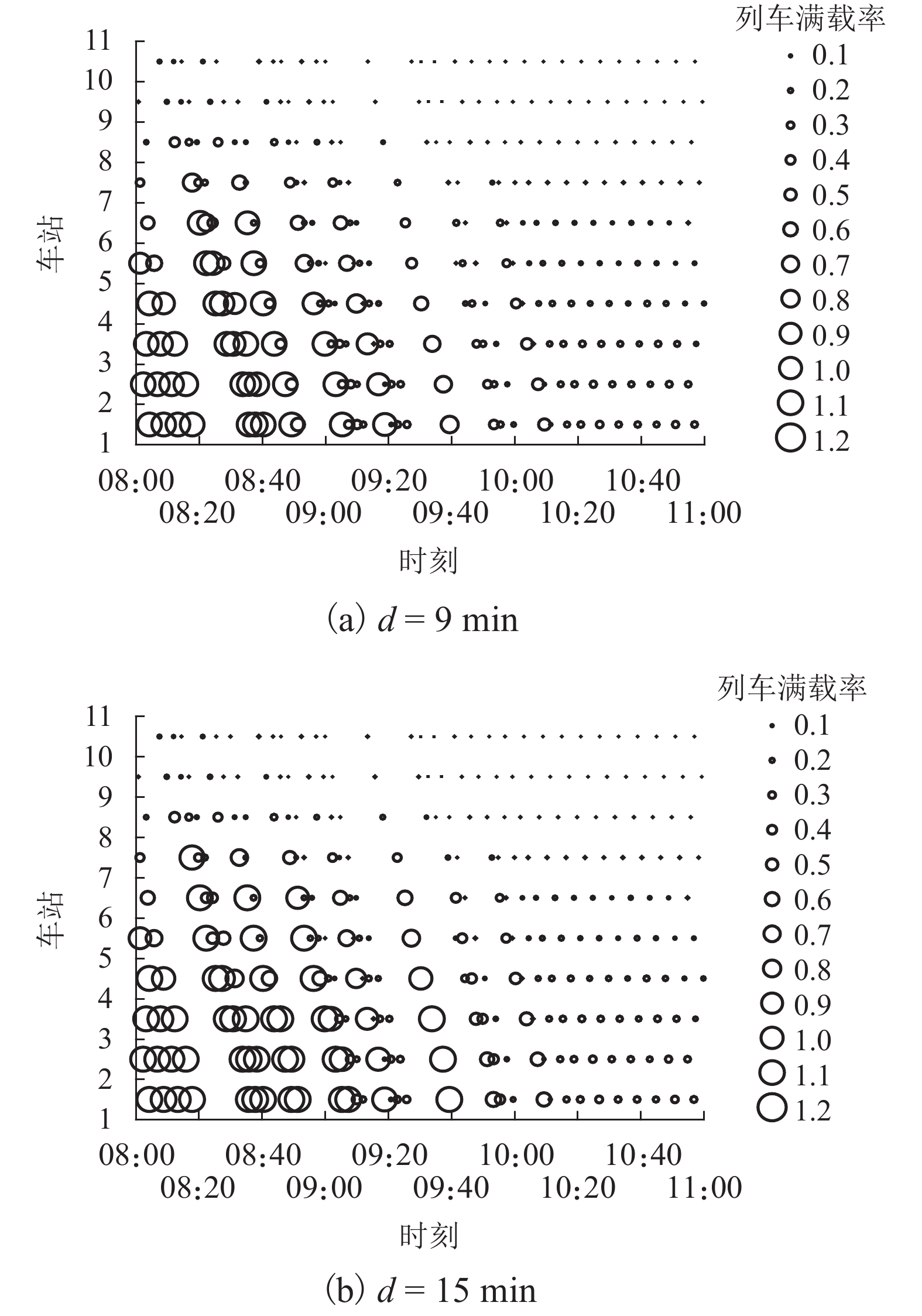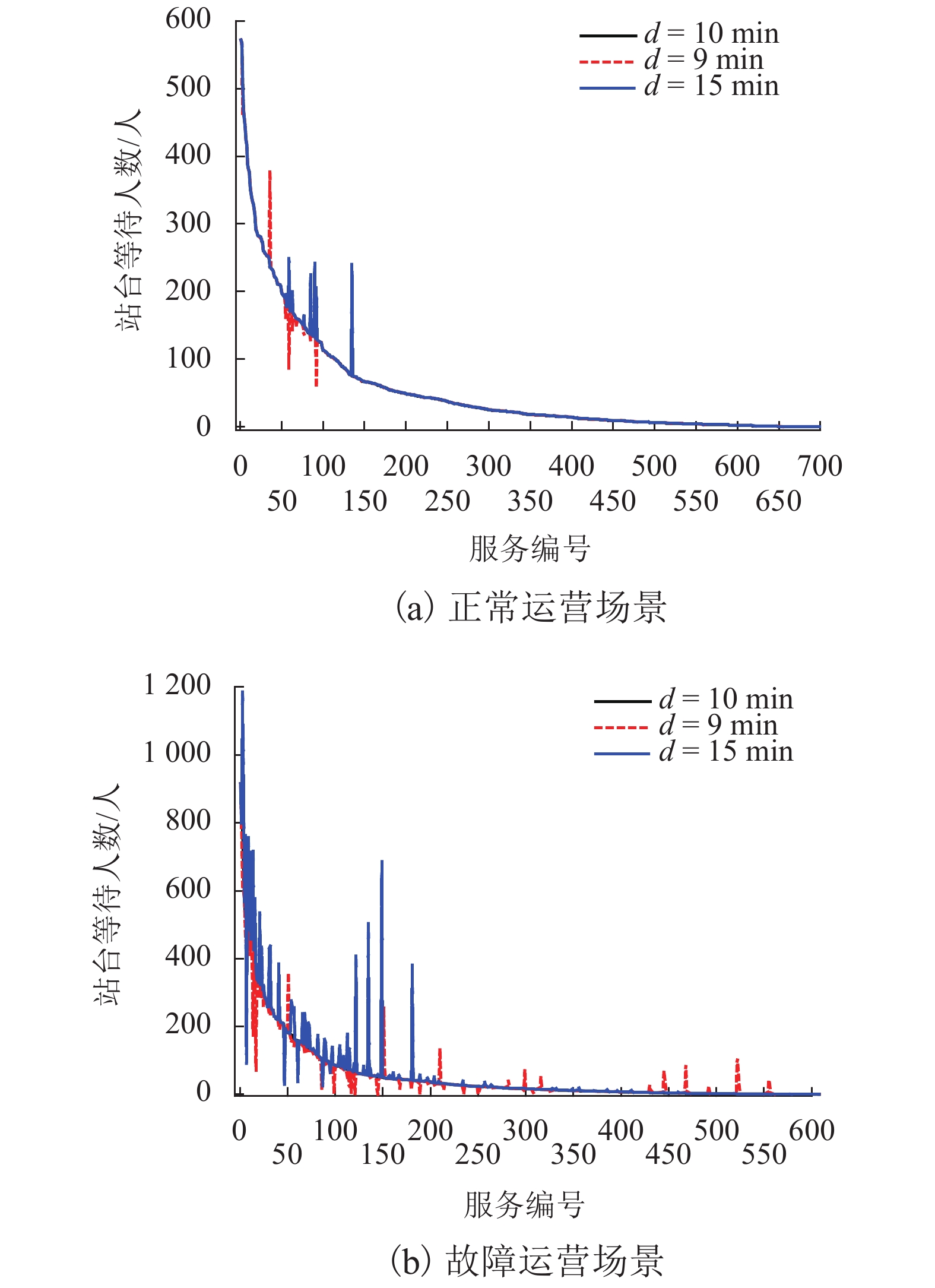Calculation and Evaluation Method of Passenger Flow Distribution under Urban Rail Transit Failure
-
摘要: 为了精细化掌握城市轨道交通故障对乘客出行的影响,对等车、上车和下车过程的客流与列车交互状态进行抽象,建立了站台等待乘客、车内乘客等客流分布数据的计算方法,设计了动态客流仿真算法及乘客服务水平评估指标. 以实际线路为背景,以正常运营场景为参照,计算和评估了故障场景下的客流时空分布,分析了乘客等待时间对列车和站台上客流分布及出行时间的影响. 算例结果表明:具体故障下乘客多等待能通过避免离开而减少部分出行时间,但与正常场景相比,列车满载率高、站台人数多的现象增多;最大等待时间15 min与9 min相比,离开人数减少77.0%,带惩罚的总旅行时间降低超过10.0%,留乘发生率一样,但最大留乘人数增加94.1%,最大等待人数增加29.6%.Abstract: In order to accurately obtain the impact of urban rail transit failures on passenger travel, the interaction states between passenger flow and train are modeled for passengers’ waiting, boarding and alighting processes. A calculation method is established for passenger flow distribution such as waiting passengers on platforms and passengers in carriages. The dynamic passenger flow simulation algorithm and evaluation indexes of passenger service level are designed. Taking an actual rail line under normal operation scenario as the reference, the space-time distribution of passenger flow under urban rail transit failure is computed and evaluated. The effect of waiting time on passenger flow distribution on platforms and in carriages and the effect of waiting time on passenger travel time are analyzed. The case study shows that, passengers wait a little longer on the platform instead of leaving, which will reduce part of travel time under the specific failure. However, the situations of high load rate in carriage and large passenger volume on platform increases, compared with the normal scenario. With the maximum waiting time increasing from 9 min to 15 min, the number of departing passengers decreases by 77.0%, the total travel time with penalty decreases by more than 10.0%, and the passenger retention rate is the same, but the maximum numbers of stranded passengers and waiting passengers increase by 94.1% and 29.6%, respectively.
-
Key words:
- urban rail transit /
- passenger flow distribution /
- interaction process model /
- simulation /
- failure
-
表 1 汇总的OD客流量
Table 1. Total OD volume
人 车站 车站 1 2 3 4 5 6 7 8 9 10 11 1 398 1689 2423 1198 1202 1776 688 489 646 742 2 1575 18 103 83 67 119 44 31 61 38 3 1656 3 51 38 58 71 33 21 47 47 4 4200 42 47 67 55 122 74 57 72 70 5 4017 110 156 73 40 97 51 34 58 35 6 2222 37 119 105 25 23 32 18 66 42 7 4219 107 149 232 54 25 33 36 154 96 8 2761 87 100 165 85 49 51 29 133 119 9 1783 36 59 110 45 43 53 21 69 63 10 176 2 5 17 14 20 10 8 4 7 11 1024 25 40 101 62 39 91 59 24 30 表 2 站台客流分布指标
Table 2. Indexes of passenger flow distribution on platforms
类别 服务
数/次d/min 最大等待数/人 最大留乘数/人 留乘发生率/% 总离开数/人 计划图 699 9 572 316 2.72 211 10 572 316 2.86 191 15 572 316 3.00 166 调整图 608 9 915 389 3.45 5564 10 915 448 3.13 4335 15 1186 755 3.45 1279 表 3 乘客出行时间
Table 3. Passengers' travel time
min 参数取值 计划图 调整图 ρ d/min 总旅行
时间总等待
时间总旅行
时间总等待
时间1.5 9 581 820 90 506 638 280 164 780 10 582 530 91 468 619 700 162 130 15 584 560 93 624 571 430 163 530 2.0 9 582 260 90 506 675 520 164 780 10 582 830 91 468 648 130 162 130 15 584 760 93 624 577 140 163 530 -
SCHACHTEBECK M, SCHÖBEL A. To wait or not to wait— and who goes first? delay management with priority decisions[J]. Transportation Science, 2010, 44(3): 307-321. doi: 10.1287/trsc.1100.0318 DOLLEVOET T, HUISMAN D, SCHMIDT M, et al. Delay management with rerouting of passengers[J]. Transportation Science, 2012, 46(1): 74-89. doi: 10.1287/trsc.1110.0375 曾璐,刘军,秦勇,等. 基于AFC数据的突发事件下城市轨道交通乘客路径决策研究[J]. 铁道学报,2019,41(8): 9-18. doi: 10.3969/j.issn.1001-8360.2019.08.002ZENG Lu, LIU Jun, QIN Yong, et al. Route choice behavior of passengers in urban rail transit under emergency based on AFC data[J]. Journal of the China Railway Society, 2019, 41(8): 9-18. doi: 10.3969/j.issn.1001-8360.2019.08.002 洪玲,高佳,徐瑞华. 城市轨道交通网络突发事件影响客流量的计算[J]. 同济大学学报(自然科学版),2011,39(10): 1485-1489.HONG Ling, GAO Jia, XU Ruihua. Calculation method of emergency passenger flow in urban rail network[J]. Journal of Tongji University (Natural Science), 2011, 39(10): 1485-1489. SUN H J, WU J J, WU L J, et al. Estimating the influence of common disruptions on urban rail transit networks[J]. Transportation Research Part A:Policy and Practice, 2016, 94: 62-75. doi: 10.1016/j.tra.2016.09.006 LIU F B, XU R H, ZHAO Z G, et al. A big data analysis method for evaluating train delay effects in urban rail transit[C]//7th International Conference on Railway Operations Modelling and Analysis (Rail Lille 2017). Lille: [s.n.], 2017: 1434-1449. GAO Y, KROON L, SCHMIDT M, et al. Rescheduling a metro line in an over-crowded situation after disruptions[J]. Transportation Research—Part B:Methodological, 2016, 93: 425-449. doi: 10.1016/j.trb.2016.08.011 WANG Y H, TANG T, NING B, et al. Passenger-demands-oriented train scheduling for an urban rail transit network[J]. Transportation Research—Part C:Emerging Technologies, 2015, 60: 1-23. doi: 10.1016/j.trc.2015.07.012 鲁工圆,马驷,王坤,等. 城市轨道交通线路客流控制整数规划模型[J]. 西南交通大学学报,2017,52(2): 319-325. doi: 10.3969/j.issn.0258-2724.2017.02.015LU Gongyuan, MA Si, WANG Kun, et al. Integer programming model of passenger flow assignment for congested urban rail lines[J]. Journal of Southwest Jiaotong University, 2017, 52(2): 319-325. doi: 10.3969/j.issn.0258-2724.2017.02.015 -






 下载:
下载:





